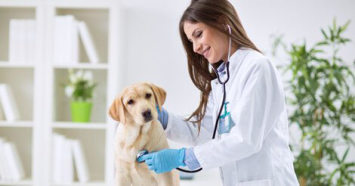
Your pet's yearly veterinary examination can be an intimidating experience for both you and your pet. Understanding what to expect will help the examination go smoothly and ensure all of your concerns for your pet are addressed.
What will happen during my pet's exam?
The veterinarian may take your pet's temperature to ensure he or she does not have a fever. This is usually performed with a rectal thermometer. Often pets are very good at hiding their illnesses, and taking the temperature is a quick way to determine if your pet is sick.
Your vet will feel and manipulate your pet's legs to ensure there are no signs of arthritis. Stiffness or lack of smooth joint movements can be an indicator of arthritis or joint disease in some pets. Your vet may palpate or squeeze areas of your pet's stomach. This is to determine if any structures within their abdomen feel abnormal, are painful, or have grown unexpectedly.
The vet may look closely at your pet's skin and hair to check for growths, signs of infection, or external parasites such as fleas. Your vet will listen to the heart and lungs with a stethoscope to check that they are functioning normally. The vet may look at your pet's eyes with or without a light to check for normal pupil function, cataracts, and assess the ocular nerve at the back of your pet’s eye. Your vet may also look in the ears to ensure no excess wax is being produced, no signs of infection are present, and the ear drums appear healthy.
Lastly, your veterinarian will look in your pet's mouth to make sure their teeth are healthy, no oral masses have developed, and that the gums have adequate color and blood flow.
What else will happen during the yearly visit?
If your pet is due for any vaccinations, the veterinarian will give them after making sure your pet is healthy. Be sure to inform your vet if your pet has had reactions to any vaccines in the past. Your veterinarian may check your pet for heartworms with a blood test or intestinal parasites with a fecal flotation test. Your vet may also run lab work to ensure your pet's internal organs are functioning well. Often, if an animal is on medication year round, lab work to test for appropriate medication levels in the blood stream may be done during the yearly exam too.
How should I prepare for my pet's exam?
Make a list of questions or concerns you have about your pet, such as if your pet is itchy, has a new mass on its skin, or has had any unusual physical changes like increased tear production recently. Be prepared to answer common questions from the veterinarian such as your pet’s typical stool consistency, your pet's normal diet, or if your pet is drinking more water than usual. These answers will help your veterinarian determine if more tests are needed and help the vet focus more specifically on certain parts of your pet's physical examination.
If your pet is doing well at home and doesn't seem to have any major issues, it is ok to mention this as well. Veterinarians keep up with your pet’s yearly physical examination and history of changes in a medical record so that next year any new changes can be addressed more easily. Noting that your pet was doing well the previous year is helpful in determining whether new issues are of concern. If you forget to ask something during the exam, or if you have new questions or concerns later, don’t hesitate to call your veterinarian’s office. They will be happy to help address your concerns in order to keep your pet as healthy as possible.